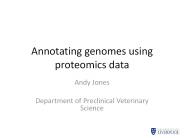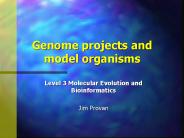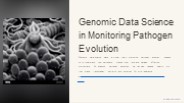Genomes PowerPoint PPT Presentations
All Time
Recommended
Life: The Science of Biology, 10e ... Genomes
| PowerPoint PPT presentation | free to download
Large scale DNA sequencing uses the dideoxy method with some ... and are the basis for DNA fingerprinting since they are hypervariable. Eukaryotic Genomes ...
| PowerPoint PPT presentation | free to view
Microbial Genomes. 1) Methods for Studying Microbial Genomes ... Bioinformatics. Databases. Literature. Sequence. Experimental. Genome Annotation ...
| PowerPoint PPT presentation | free to view
... years after the E. coli genome sequencing project and finished ... Develop technology for human genome project. Examine the genomes of a wide range of microbes ...
| PowerPoint PPT presentation | free to download
... between different animals/plants/bacteria Structural Genomics Studying structure of proteins produced by genes Pharmacogenomics How ... haplotype Similar ...
| PowerPoint PPT presentation | free to view
Investigating Genomes with Ensembl
| PowerPoint PPT presentation | free to download
... Other genomes sequenced References Chapter 9 pp 265 ... chromosme 19 has 5% Alus compared to Y chromosome ... e) The Y chromosome ! Mapping ...
| PowerPoint PPT presentation | free to view
Identifying conserved spatial patterns in genomes Rose Hoberman David Sankoff Dept. of Math and Statistics University of Ottawa Dannie Durand Depts. of Biological ...
| PowerPoint PPT presentation | free to download
Comparative genomics of 12 Drosophila genomes Bill Gelbart (in the role of Manolis Kellis) Broad Institute of MIT and Harvard MIT Computer Science and Artificial ...
| PowerPoint PPT presentation | free to download
Chapter 21 Genomes and Their Evolution * Figure 21.17 Inquiry: What is the function of a gene (FOXP2) that is rapidly evolving in the human lineage?
| PowerPoint PPT presentation | free to download
Small but essential genomes
| PowerPoint PPT presentation | free to view
Reconstructing Genomic Architectures of Tumor Genomes Pavel Pevzner and Ben Raphael Department of Computer Science & Engineering University of California, San Diego
| PowerPoint PPT presentation | free to view
Find start codons / transcriptional initiation. Recognise ... Stop codon. Genomic DNA. mRNA. Computational gene prediction. De novo prediction single genome ...
| PowerPoint PPT presentation | free to download
This classical model of the genome emerged as a synthesis of four things: ... b. Paramutation (R. A. Brink) c. Transposable 'controlling elements' (B. McClintock) ...
| PowerPoint PPT presentation | free to view
nearly 200 complete genomes have been sequenced ... Penalties are affine (event and distance. components) Penalties: regular. translocation ...
| PowerPoint PPT presentation | free to view
Automated Annotation of Microbial Genomes, Opportunities and Pitfalls Margie Romine Pacific Northwest National Laboratory Richland, Washington
| PowerPoint PPT presentation | free to download
What Have We Learned From Unicellular Genomes? Propionibacterium acnes Bacteroides thetaiotaomicron Mycoplasma genitalium Mimivirus Cyanobacteria Plasmodium
| PowerPoint PPT presentation | free to download
Computing. with Whole Genomes. Stuart M. Brown. Research Computing, NYU School of Medicine ... New types of whole genome analyses ...
| PowerPoint PPT presentation | free to view
KEY CONCEPT Entire genomes are sequenced, studied, and compared. Genomics involves the study of genes, gene functions, and entire genomes. Genomics is the study of ...
| PowerPoint PPT presentation | free to download
View the gene model of a candidate gene. Identify the genomic sequence to ... as well as from maize, sorghum, barley, wheat and other cereals that were mapped ...
| PowerPoint PPT presentation | free to view
Annotation and Alignment of the Drosophila Genomes Centro de Ciencas Genomicas, May 29, 2006. Genes or Regulation? Genes or Regulatory Elements?
| PowerPoint PPT presentation | free to view
Molecular Genetics: Questions about any virus genome will usually include the following: Composition - DNA or RNA, single-stranded or double-stranded, ...
| PowerPoint PPT presentation | free to view
'The second human genome project' (David Relman) ... Figure 1 Circular genome map showing the position and orientation of known genes, ...
| PowerPoint PPT presentation | free to view
Responsible for acne, its genome sequenced in 2004. ... Anatomy of acne. Propionibacterium acnes genome. Sequenced ... 12% encoded RNA products (rRNA and tRNA) ...
| PowerPoint PPT presentation | free to download
Endosymbiotic gene transfer: organelle genomes forge eukaryotic chromosomes. ... drive biogenesis of mitochondria and chloroplasts ...
| PowerPoint PPT presentation | free to view
Computing genomic distance between genomes is important in evolutionary ... G'=-bd-cab-d-c. We will focus on unsigned sequences in this work. ...
| PowerPoint PPT presentation | free to view
set of databases (PIDs, Genomic Rosetta Stone) An ability to grab' information for a particular ... Genomic Rosetta Stone navigate ...
| PowerPoint PPT presentation | free to view
Comparative Analysis of Human Chromosome 22q11.1-q12.3 with Syntenic Regions in the Chimpanzee, Baboon, Bovine, Mouse, Pufferfish and Zebrafish Genomes
| PowerPoint PPT presentation | free to view
... and displaying annotations on genome see more and more personal genomes becoming available Price of sequencing genomes continues to drops good choice ...
| PowerPoint PPT presentation | free to view
... Contents Predicting functional interactions between proteins Genomic context methods General Gene fusion Gene order Presence / absence of genes across genomes ...
| PowerPoint PPT presentation | free to download
Example: tiger pufferfish (Fugu rubripes), mouse (Mus musculus), and human genomes ... 25% human genes no counterparts in Fugu ...
| PowerPoint PPT presentation | free to view
Genomics. The Human Genome Project. Mapping and Sequencing the Genomes of Model Organisms ... Lander and Waterman equation. poisson distribution. Po = e-m ...
| PowerPoint PPT presentation | free to view
Decipher microbial genomes through understanding ... 2-AEP pathway (in Gram-positive microbes): Pathways to utilize phosphonates: NH2CH2CH2PO3H ...
| PowerPoint PPT presentation | free to view
This presentation gives basic information on genomics and explains terms like genomes and DNA Sequencing, that helps understand the basic concepts of Genomics.
| PowerPoint PPT presentation | free to view
6.095/6.895 - Computational Biology: Genomes, Networks, Evolution Whole-genome comparative genomics Analyzing the human genome Lecture 21 Dec 6, 2005
| PowerPoint PPT presentation | free to view
Yet genomes are rearranged in similar ways all the time: ... Meiosis/ Nuclear Exchange. Nuclear Fusion/ Duplication of. Zygotic Nucleus ...
| PowerPoint PPT presentation | free to view
Genomics, the branch of science that deals with the study of genomes and their communication with variety of stimuli, that has been the focus of widespread research and development activities in the few years. Genomics has witnessed an important rise in technologies that offer a better understanding of genomes and their interaction with the environment and apparatus that use research results for the understanding of genomes in the growth and survival of all organisms.
| PowerPoint PPT presentation | free to download
Partially sequenced genomes e.g. Drosophila melanogaster, Fugu rubripes, Oryza sativa ... Homologous genes in Fugu and mammals show conserved synteny: Same ...
| PowerPoint PPT presentation | free to download
(DHTML, Perl, CGI) Blast Output (BLASTN/P/X, TBLASTN/X) Perl Scripts (BioPerl Modules) ... (DHTML, Perl, CGI, Ajax) - Select Genomes - Query Sequences. BLAST ...
| PowerPoint PPT presentation | free to view
... the model lab organisms, including the human genome. ACTG ... Catching the crumbs from the human genome project. ACTG. Why sequence genomes? Releases resources ...
| PowerPoint PPT presentation | free to view
An integrated system for the comparative analysis of multiple genomes. ... FuzFinder (GP) MetaPath (MP) Clustering Services (CL) Connectivity of Analysis Tools ...
| PowerPoint PPT presentation | free to view
Article: 'a gene co-expression network for global discovery of conserved genetic ... Gene fusion, Rosetta stone method. Conserved gene order between divergent genomes ...
| PowerPoint PPT presentation | free to view
C value paradox: the amount of DNA in the haploid cell of an organism is not ... Newt and lungfish genomes ~ 5 and 50 x larger than human ...
| PowerPoint PPT presentation | free to view
... functional modules that are encoded in the genomes but may not be expressed ... conditions (redundant genes may be expressed only under specific conditions) ...
| PowerPoint PPT presentation | free to view
large-scale' and high-throughput' study on genes or. genomes using molecular biology ... prepare a a large number. of clones wth different inserted DNA. up to ...
| PowerPoint PPT presentation | free to view
The Global Genomics Market size is expected to reach $68.9 billion by 2027, rising at a market growth of 17.5% CAGR during the forecast period. A genome is an organism's genetic material. It includes genes, noncoding DNA, mitochondrial DNA, and chloroplast DNA, among other things. Genomic refers to the science and study of genomes. Because of its applicability in numerous fields of study, such as intragenomic phenomena such as epistasis, pleiotropy, heterosis, and other interactions between loci and alleles inside the genome, genomics is gaining massive traction in the market.
| PowerPoint PPT presentation | free to download
The genome is the genetic material of an individual, species or organism, which is responsible for the various functional characteristics of an individual. Genomics is an important aspect of genetics and molecular biology that focuses on the study of the structure, function, and mapping of genomes. It involves various applications in functional genomics, genome sequencing, comparative genomics, and genome analysis. A defect in genome structure or function could lead to the occurrence of disorders. Read more details at: http://www.bigmarketresearch.com/genomics-in-the-us-2014-2018-market
| PowerPoint PPT presentation | free to download
Genomic Data Science in Monitoring Pathogen Evolution involves using advanced genomic sequencing and data analysis techniques to track and understand how pathogens like viruses and bacteria evolve over time. By analyzing genetic changes, scientists can identify new variants, monitor transmission patterns, predict outbreaks, and guide the development of vaccines and treatments, enhancing public health responses to emerging infectious diseases.
| PowerPoint PPT presentation | free to download
CHAPTER 15 Microbial Genomics Genomic Cloning Techniques Vectors for Genomic Cloning and Sequencing MS2, RNA virus- 3569 nt sequenced in 1976 X17, ssDNA virus 5386 nt ...
| PowerPoint PPT presentation | free to view
Sharing Genomic Data and Annotations using GFF3 format Dina Sulakhe and Natalia Maltsev Bioinformatics Group MCS, Argonne National Laboratory Computation Institute
| PowerPoint PPT presentation | free to view
Comparative Genomics What is Comparative Genomics? It is the comparison of one genome to another. Genomics DNA (Gene) Functional Genomics Transcriptomics RNA ...
| PowerPoint PPT presentation | free to download
Can we actually reconstruct genome evolution ? ... Gene content evolution is a highly dynamic process. Even in the evolution towards the largest genome a large ...
| PowerPoint PPT presentation | free to view
GRAPPA: Large-scale whole genome phylogenies based upon gene order evolution ... Center for Computational Biology and Bioinformatics. Whole-Genome Phylogenetics. A. B ...
| PowerPoint PPT presentation | free to download
Title: Genome-wide characteristics of sequence coverage by next-generation sequencing: how does this impact interpretation? Author: Taylor, Jen (PI, Black Mountain)
| PowerPoint PPT presentation | free to view
























































